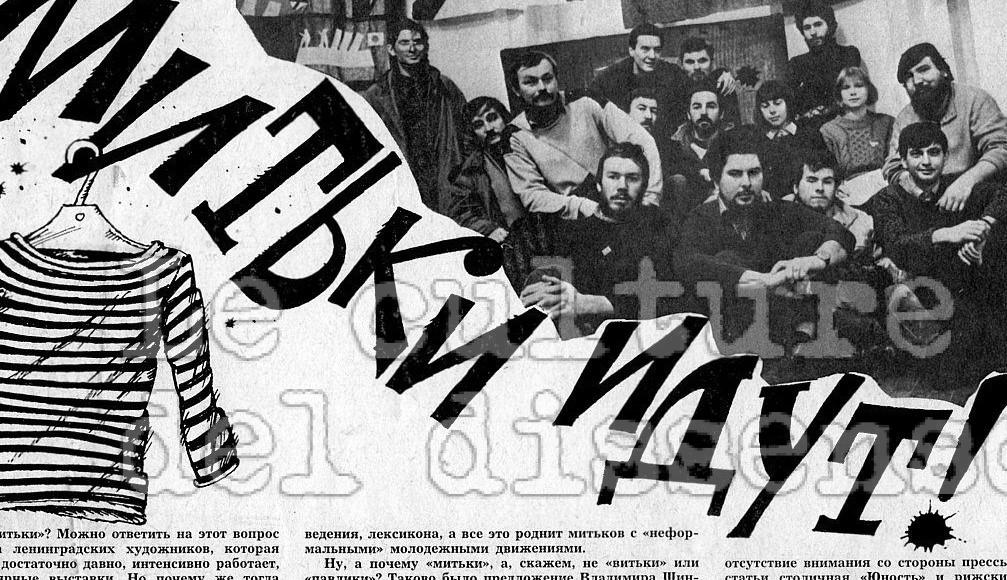
04 Dec MITKI
DATES:
1985 – ongoing
PLACE:
Leningrad – Saint Petersburg
MEMBERS:
Dmitrij Shagin, Vladimir Shinkarev, Vladimir Yashke, Aleksandr Florensky, Olga Florenskaya, Mikhail Sapego and more (listed in http://mitki.kulichki.com/russian/members/).
PUBLISHING INITIATIVES:
Periodical releases of the «Mitki-gazeta» magazine (1992-1998); foundation of the Mitkilibris (1994) and the Krasnyj matros (1995) publishers.
DESCRIPTION:
The origins of the Mitki group can be traced to one of the first groups of soviet non-conformist art, the “Arefevtsy” whose influence is also evident in their name: indeed, the singular of mitki, “mityok”, is the term of endearment that Vladimir Shagin, one of the members of the Arefevtsy, used for his son Dmitry, a leading figure of the Mitki. The group’s history began one day in 1984, when Vladimir Shinkarev sketched his friend Dmitry, or rather “some of his personality traits in the image of a mityok”. In the drawing, Shagin is wearing the typical telnyashka (the blue and white horizontal striped shirt, typical of Russian sailors), that afterwards the mitki wore on public occasions. This picture and others like it, by artists who were already becoming well known, were widely circulated in the underground circles in the northern capital and by 1985 the Mitki had emerged as a group. This group is made up of painters influenced above all by the Russian-Soviet avant-garde and neo-avant-garde traditions, but also includes several writers and poets, such as Mikhail Sapego, as well as Shinkarev and Shagin. Their works in verse and prose are often autobiographical and reinforce their own myth, as well as reaching out to a wider audience. Reality and imagination blend, as often happens in the illusory and deceptive atmosphere of their hometown. There is a desire to create close connections between word and image (also found in the work of the Arefevtsy) and an acceptance of other artistic forms such as music: in addition to the interpretations of Vladimir Vysotsky’s songs, it’s worth mentioning the group’s collaboration with various singers and musicians, including Boris Grebenshchikov and Yuri Shevchuk. The group has also worked with legends of independent poetry such as Viktor Krivulin or Konstantin Kuzminsky. The Mitki’s embrace of alcohol and loitering about, which is almost assumed as way of life, pays homage to their cultural forefather’s (Kharms, Khvostenko, Tsoi, Grebenshchikov, Vysotsky) and demonstrates an attraction towards aspects of the hippie culture. The mild, submissive and at once energetic spirit of the group and the lingering goliardic and zany stance of its members is combined with a real idolization of alcohol, that in Russia is a quintessential aspect of identity, especially during the prohibitionist era inaugurated (and quickly abandoned) by Mikhail Gorbachev. This glorification of butylka ended in the Nineties, when the excesses of previous years forced many Mitki to embark on a timely detox. The group’s first exhibition took place in 1985 near Leningrad, in Ust-Izhora and within a few years they had become objects of mass worship for young people disoriented by the political and social cataclysms of the period. In the Nineties exhibitions were also organized in the United States and in Europe (in 1996 in Cagliari). In 1993 the Russian Museum organized a retrospective to mark ten years of activity and three years later the Mitki-VCHUTEMAS gallery opened in Saint Petersburg, a meeting place for young painters and writers as well as a venue for alcoholics anonymous.
BIBLIOGRAPHY:
M. Caramitti, Letteratura russa contemporanea: La scrittura come resistenza, Laterza, Bari 2010, pp. 151-153.
L.Piccolo, I mit’ki, «Russica Romana», XI, 2004, pp. 149-157.
M. Sabbatini, «Quel che si metteva in rima»: cultura e poesia underground a Leningrado, Europa Orientalis, Salerno 2008, pp. 319-325.
P. Vajl’, V napravlenii mitkov, «Ogonek», 51 (1995), pp. 86-87.
WEB SOURCES:
http://mitki.kulichki.com/, group’s website.
FILMOGRAPHY:
Mitki nikogo ne khotyat pobedit, ili Mit’kimajer (by A. Vasil’ev, 53 min., 1992).
[Federico Iocca, 18/5/2018]
[Translation by Alice Bucelli]





